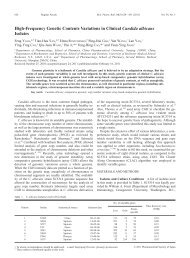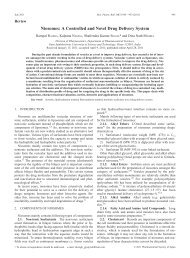Chem. Pharm. Bull. 59(1): 57-62 (2011)
Chem. Pharm. Bull. 59(1): 57-62 (2011)
Chem. Pharm. Bull. 59(1): 57-62 (2011)
You also want an ePaper? Increase the reach of your titles
YUMPU automatically turns print PDFs into web optimized ePapers that Google loves.
58 Vol. <strong>59</strong>, No. 1<br />
Hayashi Kasei Co., Ltd. (Osaka, Japan) 0.3 g, and magnesium stearate made<br />
by Merck KGaA. (Darmstadt, Germany) 0.3 g were measured precisely, then<br />
stirred and mixed for 5 min at 1000 rpm using a mixer. A desktop-type<br />
tableting machine (Minipress-MII, Stec, Kanagawa, Japan) was set up so<br />
that this mixed powder could be formed into tablets weighing about 110 mg,<br />
with tablet diameter of 6 mm and tablet thickness of 3 mm, using a tableting<br />
pressure of 6.5 kN.<br />
XRPD XRPD data were obtained using a Rigaku (Tokyo, Japan)<br />
RINT2200 powder diffraction system, equipped with an Ultima � (Tokyo,<br />
Japan) goniometer I-type in q/2q geometry. The X-ray generator was operated<br />
at 40 kV and 20 mA, using CuKa radiation (wavelength 1.5418 Å). The<br />
scans were performed at room temperature in the range between 5° (2q) and<br />
25° (2q), with a scan rate of 2°/min and step size of 0.02°. The slits used<br />
were: 0.5° (DS); 0.3 mm (RS); and 0.5° (SS). The number of measurement<br />
was once for each experiment.<br />
Dynamic Vapor Sorption Dynamic vapor sorption (DVS) data were<br />
obtained using Surface Measurement Systems (SMS) Ltd. equipment (London,<br />
U.K.). Samples were stored at 25 °C and 87% RH for 10 d. While monitoring<br />
changes in weight during that time, changes in the appearance of the<br />
samples were photographed with a CCD camera at specific times.<br />
Synchrotron XRPD Synchrotron XRPD data were recorded at 300 K<br />
on beamline BL19B2 at SPring-8 (high resolution type Debye-Scherrer<br />
camera equipped with a curved imaging plate detector) with wavelength<br />
0.69817(5) Å. The exposure time was 20 min for one diffraction image, allowed<br />
to fade for 10 min, and then read with a scanner. A glass capillary was<br />
glued to the center of the tablets to serve as a rotating wheel axis, then it was<br />
fixed to the goniometer head with height adjustment. The measurements<br />
were performed while rotating the tablet at the rate of one revolution per second<br />
with the incident direction taken as the tablet radial direction (perpendicular<br />
to the rotating wheel axis) so that synchrotron radiation irradiated an<br />
entire tablet. The number of measurement was once for each experiment.<br />
Calibration Curve In the combination of the intensity of XRPD peak at<br />
10.27° (2q) for the form II and 11.46° (2q) for the form I, an approximation<br />
of a linear equation was performed employing the least squares method, and<br />
a calibration curve was prepared. On the other hand, in the combination of<br />
8.11° (2q) for the form II and 8.58° (2q) for the form I, approximation to a<br />
secondary equation was performed employing the least squares method, and<br />
a calibration curve was prepared, because the peak intensity ratio differs<br />
greatly when an equimolar mix of the two is made (the peak intensity ratio<br />
of form II is about three-fold greater than that of form I).<br />
Calculation of the Transition Kinetic Constant Using the Prout-<br />
Tompkins Equation Calculation of the kinetic constant of the crystalline<br />
transformation (form I to form II) in samples stored under each temperature<br />
and humidity condition was carried out using Origin ver. 6J software (Microcal<br />
Software, Inc., Northampton, MA, U.S.A.) using the following Prout-<br />
Tompkins equation (Eq. 1). 2) Curve fitting was performed employing the<br />
nonlinear least squares method with the Levenberg–Marquardt algorithm<br />
using over seven data points.<br />
⎛ y ⎞<br />
log⎜<br />
⎟ �Kt �C<br />
⎝ 1� y ⎠<br />
where y is the molar ratio of form II, t is time (d), K is the kinetic constant,<br />
and C is a constant term.<br />
For calculation of the half-life (from form I to form II), curve fitting was<br />
performed as in the above kinetic constant calculation employing the following<br />
Boltzmann function (Eq. 2).<br />
�1<br />
y �<br />
� 12 / 1�<br />
e<br />
( t t )/ dt<br />
�1<br />
where y is the molar ratio of form II, t is time (d), t 1/2 is half-life (d), and dt<br />
is a time constant measured in the experiment.<br />
Calculation of Activation Energy The logarithmic value of the kinetic<br />
constant of the crystalline transformation at each RH was plotted for each<br />
temperature. An approximation to a linear equation was performed employing<br />
the least squares method. Based on relational expressions obtained here,<br />
a simulation was performed of the temperature dependency of the crystalline<br />
transformation kinetic constant at RH of 70%, 75%, 80%, 85%, and 90%.<br />
Furthermore, at each RH, the kinetic constant of the crystalline transformation<br />
was plotted for each absolute temperature (Arrhenius plots). At each<br />
RH, fitting was carried out to a linear equation using the least squares<br />
method, and the activation energy for each RH was calculated based on the<br />
inclination of this linear equation.<br />
(1)<br />
(2)<br />
Results and Discussion<br />
Pseudo-Crystalline Transformation Behavior from<br />
Form I to Form II At the beginning of this experiment, the<br />
crystal forms of those materials were checked by XRPD for<br />
according to the XRPD patterns of form I and form II on the<br />
previous reports, 2—4) and solid state NMR for the purity of<br />
crystal forms. In this result, those materials were confirmed<br />
form I and form II, and had good crystal purity. Generally<br />
speaking, the detection limit of crystal impurity is a few percentages<br />
by solid state NMR 9) (data not shown).<br />
While storing form I crystals at 87% RH using the DVS<br />
and monitoring the changes in weight during that time,<br />
changes in the crystalline appearance were observed with the<br />
CCD camera as shown in Fig. 1. From the start of measurement,<br />
a significant weight increase of form I due to moisture<br />
absorption was observed about 5 d afterward, and 2 d after<br />
that, i.e., at 7 d of storage, a sharp decrease in weight (moisture<br />
desorption) was observed. Form I had good flowability<br />
in powder form at the time of preparation, and deliquescence<br />
in the crystal surface was seen when the rapid increase in<br />
weight occurred after about 5 d. After the subsequent weight<br />
reduction, it reverted to white crystals.<br />
Based on the results observed when form I was stored at<br />
high RH, we assume that the following occurred gradually:<br />
1) Moisture was adsorbed on the form I crystal surface. 2)<br />
Part of the form I crystals dissolved (deliquesced) in the adsorbed<br />
moisture. 3) Since form II has less solubility in water<br />
than form I, a recrystallization transformation to form II<br />
crystals occurred. 4) Since form II crystals are hemihydrates,<br />
they release moisture and their weight decreases. In addition,<br />
after examining the XRPD data of samples after this measurement<br />
period, complete transformation into form II (hemihydrate)<br />
was confirmed. Therefore, it was concluded that the<br />
pseudo-crystalline transformation rate from form I to form II<br />
was markedly affected by the temperature and RH during<br />
storage.<br />
Then, the behavior of the pseudo-crystalline transformation<br />
to form II after form I was stored under various temperature<br />
and humidity conditions was examined. Form I crystals<br />
were placed in a desiccator at 25 °C, 30 °C, 40 °C, and 50 °C<br />
with saturated salt solutions of sodium chloride, potassium<br />
Fig. 1. Gravimetrics of Thiamine Hydrochloride Form I in Humid Conditions<br />
(25 °C, 87% RH): Time Course of Weight Change Shown in Photos<br />
Taken with a CCD Camera during Storage<br />
(a), Initial status; (b), at 6 d of storage; (c), at 10 d of storage.




